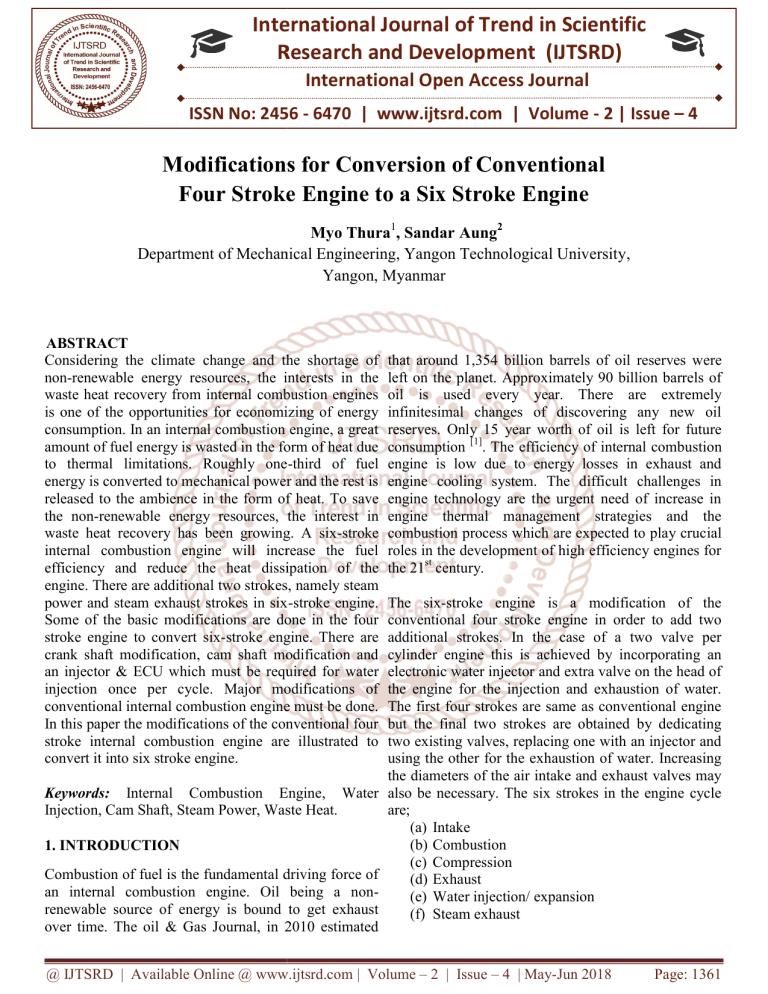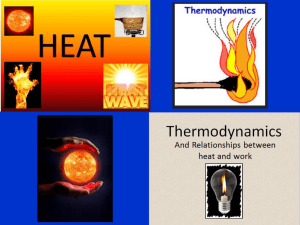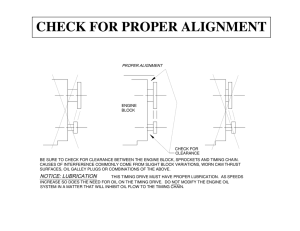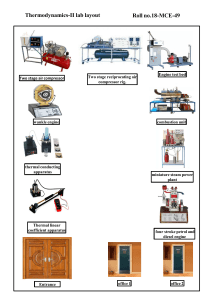
International Journal of Trend in Scientific
Research and Development (IJTSRD)
International Open Access Journal
ISSN No: 2456 - 6470 | www.ijtsrd.com | Volume - 2 | Issue – 4
Modifications for Convers
Conversion
ion of Conventional
Four Stroke Engine to a Six Stroke Engine
Myo Thura1, Sandar Aung2
Department of Mechanical Engineering, Yangon Technological University,
University
Yangon, Myanmar
ABSTRACT
Considering the climate change and the shortage of
non-renewable
renewable energy resources, the interests in the
waste heat recovery from internal combustion engines
is one of the opportunities for economizing of energy
consumption. In an internal combustion engine, a great
amount of fuel energy is wasted in the form of heat due
to thermal limitations. Roughly one
one-third of fuel
energy is converted to mechanical power and the rest is
released to the ambience in the form of heat. To save
the non-renewable
renewable energy resources, the interest in
waste heat recovery has been growing. A six
six-stroke
internal combustion engine will increase the fuel
efficiency and reduce the heat dissipation of the
engine. There are additional two strokes,
es, namely steam
power and steam exhaust strokes in six
six-stroke engine.
Some of the basic modifications are done in the four
stroke engine to convert six-stroke
stroke engine. There are
crank shaft modification, cam shaft modification and
an injector & ECU which must
ust be required for water
injection once per cycle. Major modifications of
conventional internal combustion engine must be done.
In this paper the modifications of the conventional four
stroke internal combustion engine are illustrated to
convert it into six stroke engine.
Keywords: Internal Combustion Engine, Water
Injection, Cam Shaft, Steam Power, Waste Heat.
1. INTRODUCTION
Combustion of fuel is the fundamental driving force of
an internal combustion engine. Oil being a non
nonrenewable source of energy is bound to get exhaust
over time. The oil & Gas Journal, in 2010 estimated
that around 1,354 billion barrels of oil reserves were
w
left on the planet. Approximately 90 billion barrels of
oil is used every year. There are extremely
infinitesimal changes of discovering any new oil
reserves. Only 15 year worth of oil is left for future
consumption [1]. The efficiency of internal combustion
comb
engine is low due to energy losses in exhaust and
engine cooling system. The difficult challenges in
engine technology are the urgent need of increase in
engine thermal management strategies and the
combustion process which are expected to play crucial
cruc
roles in the development of high efficiency engines for
the 21st century.
The six-stroke
stroke engine is a modification of the
conventional four stroke engine in order to add two
additional strokes. In the case of a two valve per
cylinder engine this is achieved
hieved by incorporating an
electronic water injector and extra valve on the head of
the engine for the injection and exhaustion of water.
The first four strokes are same as conventional engine
but the final two strokes are obtained by dedicating
two existing
ng valves, replacing one with an injector and
using the other for the exhaustion of water. Increasing
the diameters of the air intake and exhaust valves may
also be necessary. The six strokes in the engine cycle
are;
(a) Intake
(b) Combustion
(c) Compression
(d) Exhaust
(e) Water injection/ expansion
(f) Steam exhaust
@ IJTSRD | Available Online @ www.ijtsrd.com | Volume – 2 | Issue – 4 | May-Jun
Jun 2018
Page: 1361
International Journal of Trend in Scientific Research and Development (IJTSRD) ISSN: 2456-6470
2456
In a six-stroke
stroke engine, the fifth stroke starts at the end
of the exhaust stroke, when the piston is at TDC; the
electronic injector will spray water in the cylinder.
The water that enters the combustion chamber uses
the heat of combustion and turns to steam. This steam
expands and exerts pressure on the piston combined
with the rotational inertia of the engine, causing extra
power stroke without using fuel. When the piston
reaches BDC, the exhaust valve opens
pens and the steam
is pushed out of the combustion chamber by the
upward motion of the piston. Heat is generally
dissipated through the radiator is utilized to increase
the work of the engine. The amount of work obtained
from the same quantity of fuel incr
increase, thus
improving thermal efficiency. Bruce Crower
managed to develop the first six-stroke
stroke using a
modified single cylinder diesel engine in 2006. After
the exhaust stroke, water is injected into the cylinder
and a steam form forcing the piston back dow
down and in
turn cools the engine. The result is normal level of
power using much less fuel and no need for an
external cooling system [2].According to Crower’s
design, water is injected only after the exhaust stroke
is completely finished. In order to recove
recover the waste
heat, a new idea has been proposed by J.C.Conklin
and J.P.Szybist in 2009. The idea is to trap and
recompress the exhaust gas from fourth piston stroke
followed by a water injection and expansion of the
resulting steam exhaust mixture [3]. Improving the
efficiency of internal combustion engine is an
ongoing area of active research. Numerous designs
have been proposed on the traditional Otto and Diesel
cycle. Fig.1 shows a schematic of typical four stroke
sequence for an Otto cycle and Fig.3 illustrates the
corresponding pressure volume trace. The modified
cycle proposed here adds two additional strokes that
increase the work extracted per one time input of fuel
energy. Fig 2 illustrates six stroke sequence and Fig 4
illustrates the corresponding
ing pressure volume trace.
Fig.3. Schematic of pressure vs. volume for a typical
gasoline engine Otto cycle. [4]
Fig.4. Schematic of pressure vs. volume for a sixsix
stroke engine cycle. [4]
Fig.1. Schematic of typical intake and exhaust valve
events for a gasoline engine. [4]
II.
ENGINE MODIFICATIONS
To convert six-stroke
stroke engine from conventional fourfour
stroke engine, a few modification must be done to be
sure that the new engine with six-stroke
six
will run
successfully.
A. Crank Shaft to Cam Shaft Ratio Modification
In conventional four-stroke
stroke engine, the crank shaft
must rotate 2 revolution while the cam shaft rotate
@ IJTSRD | Available Online @ www.ijtsrd.com | Volume – 2 | Issue – 4 | May-Jun
Jun 2018
Page: 1362
International Journal of Trend in Scientific Research and Development (IJTSRD) ISSN: 2456-6470
2456
one revolution for one complete cycle. However, the
crank shaft must rotate 3 revolution for one
revolution of camshaft. The crankshaft to cam shaft
gear ratio must be changed to 3:1 as shown in Fig 5.
Fig.7. Cam lobes for inlet and exhaust valves of sixsix
stroke engine
Fig 5 Crank Shaft and Cam Shaft gear mesh
C. Change Head Design
The fifth stroke of six-stroke
stroke engine requires wafter
injection which requires additional hardware to be
added to the head. Remove some cooling fin from
original head and drill a hole for injector. Fig 8 shows
the modified cylinder head.
B. Cam Shaft Modification
The original camshaft has two lobes, one for the
intake valve and one for the exhaust valve. The
camshaft is shown in Fig 6. Each lobe is contact with
a flat follower pushrod which move a rocker arm
inside of the head. The other side of the rocker arm
pushes
es the valve inside of the cylinder. A valve
spring returns the valve inside of the cylinder. A
valve spring returns the valve back to the original
position.
For camshaft modification, a steel shaft is used as the
base and machined down to fix the existi
existing bearing
in the crankcase. The lobes have been cut from steel
slightly over size and ground down for more
accuracy. The lobes are then welded onto the shaft at
the proper angle. The gear is placed on a shaft and
uses a key to lock it into position. The llobe for inlet
valve is not changed but the lobes for exhaust valve
is changed as shown in Fig 7.
Fig .8.Modified engine head for six stroke
D. Water Injector and ECU
Since the water injection must be electronically
controlled, the water injection system consists of
three main components, the injector, the water
pressuring system and electronic control system. Fig
9 shows
hows an injector and water tank for water
injection. A program for the ECU has been written
and loaded onto micro controller. This code take the
input from both the optical sensor and encoder to
uses then to generate a timing cycle for the physical
component
nt as shown in fig 10.
Fig 6 Camshaft for six-stroke
stroke engine
@ IJTSRD | Available Online @ www.ijtsrd.com | Volume – 2 | Issue – 4 | May-Jun
Jun 2018
Page: 1363
International Journal of Trend in Scientific Research and Development (IJTSRD) ISSN: 2456-6470
The disadvantage of six stroke engine are;
1.
High initial cost due to change in gears,
injector, ECU and camshaft modification.
2.
High manufacturing cost in six stroke engine.
3.
Engine head and crank case modifications
CONCLUSIONS
The six-stroke engine modification reduces the fuel
consumption of an internal combustion engine. That
will increase the fuel efficiency of the engine.
Fig.9. Injector for water injection
The injected water is heated by waste heat from the
cylinder and the second power stroke is developed
without fuel. It improves thermal efficiency of the
engine by developing extra power from waste heat
energy. The use of waste heat energy, the world
energy demand on the fossil fuel reserves would be
reduced.
In this paper the modifications required to convert the
four stroke engine to six-stroke engine are illustrated.
In spite of some balancing and vibration problems
with multi cylinder engine the fuel efficiency would
be increased by the development of six-stroke engine.
Fig .10. Arrangement diagram for six-stroke engine
Fi
REFERENCES
1) Balse A.U, Sharma S.U, “ Design and
Experimental Construction of a Six stroke Engine
with Water Injection” International Journal of
Automobile Engineering, Volume 5, Issue 2, Aug
2015.
2) M.M.Gasim, L.G.Chui and K.A. Bin Anwar “Six
Stroke Engine Arrangement”
May 2, 2012.
3) J.C.Conklin and J.P.Szybist, A Highly Efficient
Six-stroke Internal Combustion Engine Cycle
with Water Injection for in-cylinder Exhaust Heat
Recovery. Energy, The International Journal,
volume 3S, issue 4, PP. 1658-1664 (2010).
Fig 11. Testing encoder
III. ADVANTAGES AND DIS ADVANTAGES
OF SIX STROKE ENGINE
The advantages of six stroke engine are;
1. Thermal efficiency will increase above 40%
(30% for the conventional four stroke engine.)
2. Fuel consumption reduced by about 40% [5].
3. Reduction of chemical and thermal pollution.
4. Two expansion (work) through six stroke.
5. Eliminate the radiator and cooling system.
4) Crower b, Method and apparatus for operating an
internal combustion engine.
United States patent application 20070022977;
2005.
5) Tejaskumar U Kothari, ‘Design and Analysis of
Six stroke Internal Combustion Engine’.
2014 IJEDR, Volume2, issue2, ISSN: 2321-9939
@ IJTSRD | Available Online @ www.ijtsrd.com | Volume – 2 | Issue – 4 | May-Jun 2018
Page: 1364



